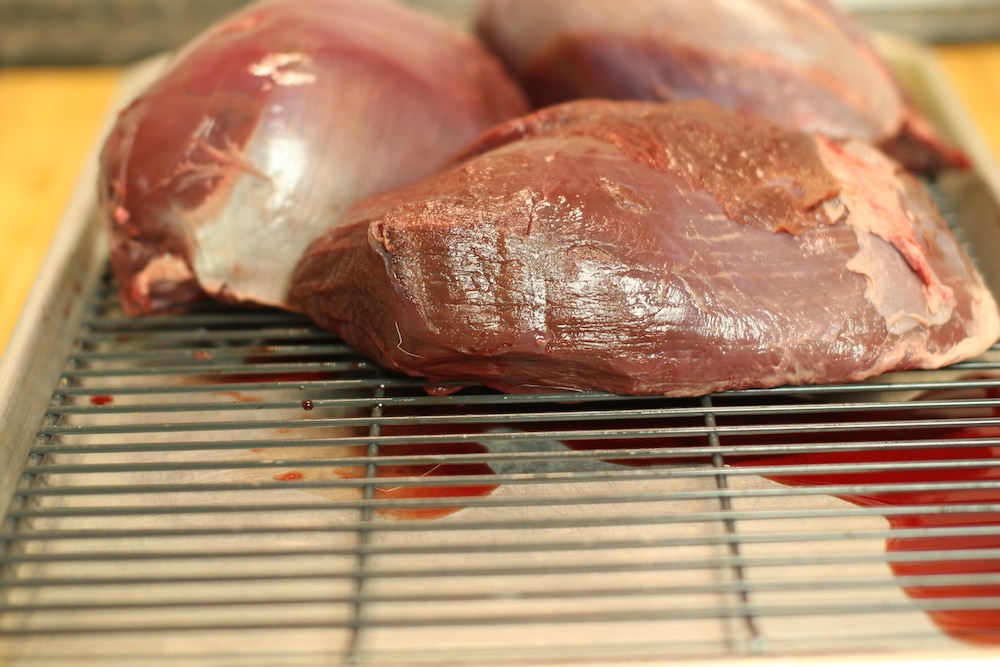The work you put in shooting, scouting and waiting paid off. You bagged a white-tailed buck. Now, as many hunters say, the real work begins. They’re referring to the work of processing all the delicious meat.
Once an animal is down, it’s the hunter’s responsibility to harvest the meat. While some bowhunters choose to process the entire animal themselves, others take it to meat processors. These expert meat handlers will age the meat, cut it up, wrap it and return the meat to the bowhunter.
There are many benefits to using a meat processor. Some bowhunters don’t have the time, tools or space to butcher an entire animal themselves. Meat processors can also create specialty items like sausage and bratwurst. While meat processors are experts in what they do, they’re only as good as the meat they’re given. It’s important to care for your meat before dropping it off.
Field-dressing a deer — removing the guts to give the meat the opportunity to cool down — is a critical step in keeping the meat from spoiling. Whenever you go into the field, carry a field-dressing kit. This should include a sharp knife, bone saw and latex gloves.
Field-dress the animal as soon as possible. You have time to take pictures and enjoy the moment, but remember the longer you wait, the more likely the meat will spoil. Most hunters choose to field-dress in the field. It’s important to take your time during the process, not only for safety reasons but to try to keep the meat clean. You want to avoid getting the contents of the stomach or intestines on the meat.
“Sometimes we’ll see that hunters make a good shot on an animal, but they just don’t have the experience field-dressing. So, they make a wrong move with the knife and get guts all over the meat. Try to clean that up as much as possible,” said Tyson Wibbenmeyer, president of Stonie’s Sausage Shop in Perryville, Missouri.
In case of a gut shot or a bad cut, Wibbenmeyer encourages hunters to use water to clean the meat. This doesn’t mean river water nearby. Use clean water from a water bottle or hose to rinse down the meat and remove any hair or guts.
Meat spoils quickly when it’s hot. Removing the guts helps cool down the meat by exposing it to air. This is particularly important when it’s hot outside. Some hunters will then pack the body cavity with ice if it’s really hot out.
Once the animal is field-dressed, get it to the processor as soon as possible. Most meat processors are open seven days a week during hunting season. It’s not a bad idea to know the operating hours ahead of time. You may even want to call before making the trip. Sometimes meat processors get too full, so you may have to wait to drop off the meat or find another company.

The color of the meat can tell you if it’s spoiled. Photo Credit: Bowhunters United
Unfortunately, sometimes when you’re bowhunting, recovering the animal takes time. For example, you’re advised to wait several hours before searching if you suspect you made a bad shot. Sometimes, if hunters make a bad shot right before dark, they’ll wait until the next morning to look. It happens. But the bottom line is that the longer you wait to field-dress the animal, the more at risk the meat is for spoiling.
“I get asked this question a lot and there’s no black-and-white answer about the time frame,” Wibbenmeyer said.
Wibbenmeyer said a lot of factors go into determining if the meat will be OK. This includes the amount of time that has passed and the outside temperature. There will be some signs to look for, including the color and smell.
“The inside of the hams are the first things to look at,” Wibbenmeyer said. “If there is green discoloration inside of hams that is a good indication that it’s already spoiled, but we won’t know until we get it in and look at it.”
Don’t just assume the meat is bad if it’s been several hours. Wibbenmeyer encourages hunters to field-dress the animal and take it into a processor for their expert opinion.
“We’ll bone it out and start checking it over, using techniques like smelling it, looking at it and seeing what the texture is like,” Wibbenmeyer said.
Wibbenmeyer said one of the biggest mistakes he sees from hunters is not understanding how the processor would like the meat. For example, his company hangs the animal by the back tendons.
“Sometimes hunters will cut those tendons on the back legs, which will prevent us from hanging it and so we will have to get really creative. Some processors won’t even take the deer unless the tendons are intact,” Wibbenmeyer said.
The best way to avoid making this mistake and others is to do your research before going afield. Many processors will have a FAQ section on their website with important information about accepting meat. Review this information so you’re prepared.
Bowhunting is rewarding in many ways — from the experiences in the field to the skills learned and the meat on your table. Be prepared and do your part to make sure you get the best quality meat possible.